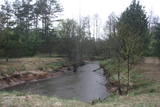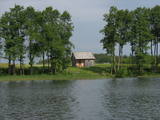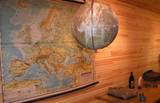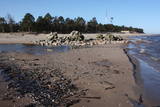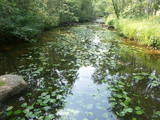| Nr | Name | Beschreibung |
|---|---|---|
|
Kultūrvēsturiska taka (garums ~ 2 km) Tipu (Tipu) ciemā, kas iepazīstina ar vairākiem interesantiem objektiem: veco skolu (1931. g.), Hallistes upi, pirti un Paunas saimniecību, kurā dzimis viens no Igaunijas nacionālās kustības līderiem Villems Reimans (1861. – 1917.). |
||
|
Laila Kelle works in a building of the former Lamiņi semi-estate. She teaches drawing and painting of landscapes and still life paintings, using oil paints for this purpose. Nature trail (3km).
|
||
|
Nature restricted area is located to the South from former railroad Ventspils-Liepaja and includes approximately 6 km of Uzava River (and the old drainage system). The territory was used for agriculture during Soviet time, now it starts overgrow by scrubs. The protected nature values – rare bird species, including corncrakes, variety of grassland habitats and plant species. Territory is not useable for tourism activities. There is a possibility to get good insight into the North part of restricted area from the road Alsunga – Berzkalns where information stand is located.
|
||
|
Līčiem, pussalām un salām bagāts ezers ar izrobotu krasta līniju, kas savienots ar Zvejnieku un tālāk - citiem Latgales augstienes ezeriem. Ozolu un platlapju meži, kas aug uz ezera salām un pussalās ir ne tikai aizsargājami, bet arī Latvijas mērogā nozīmīgi biotopi. Tiesa, to vērtību apzināsies tikai vides speciālisti. No Jašas ezera var uzsākt laivu braucienu pa vienu no Latgales ezeru "kēdēm". Ezera austrumu krastā atrodas Geļenovas parks.
|
||
|
The farmstead "Vitolini" specializes in horse breeding, as well as horse-riding lessons. It is possible to go horse-riding in the forest or to take a ride in a horse team. |
||
|
Das Museum wurde im Jahr 1982 gegründet und stellt die Geschichte und Leben der Ortschaft seit II. Hälfte des 19. Jahrhunderts bis zur Gegenwart vor. Als Ausstellungssaal dient eine ehemalige Scheune. In den Parks auf der 17 ha grossen Fläche des Museums wachsen rund 200 Baum- und Straucharten. Gäste können an verschiedenen Thementagen teilnehmen – Brotbacken, Festtage des Volkskalenders etc. Im Museum beginnt der natur- und kulturgeschichtliche Lernpfad Velise. |
||
|
Das Kap Kolka – ist das ausgeprägteste Kap an der lettischen Meeresküste, wo man den Zusammenstoß
der Wellen von zwei „Meeren“ – der Ostsee (das große Meer) und der Bucht von Riga (das
kleine Meer) beobachten kann. Das Kap geht noch fünf Kilometer als Sandbank weiter ins Meer bis
zum Leuchtturm von Kolka. Am Kap Kolka geht die Sonne im Meer auf und runter, deshalb kann man
hier phänomenale Sonnenaufgänge und Untergänge beobachten. Das Kap Kolka ist aber auch ein
gefährlicher Platz für Schwimmer wegen der unbeständigen Strömungen und Treibsand. In den
Dünen beim Kap Kolka ist ein von Bildhauer G. Burvis gefertigtes Denkmal für „Die vom Meer Genommenen“
aufgestellt. Es ist eine symbolische Pforte, durch die man den Leuchtturm von Kolka sehen
kann. Noch gibt es ein altes Schiffswrack, den Stein – das Zentrum Europas und K. Valdemars
gewidmete Informationsstände zu besichtigen. Von außen kann man auch eine alte sowjetische
Militärbasis besichtigen, die heutzutage vom lettischen Grenzschutz genutzt wird. Während der
Frühlingsmigration
der Vögel ist das Kap ein bedeutender Platz für Wandervögel, die hier Rast machen
und sich erholen. Dieses Naturschauspiel lockt viele Vogelbeobachter an. Für die Bequemlichkeit der
Besucher gibt es einen Parkplatz, Bänke mit Tischen und ein Besucherzentrum. In der Sommerzeit gibt
es auch ein kleines Café – eine großartige Möglichkeit sich zu kräftigen!
|
||
|
Ein einzigartiges Territorium in Lettland, großflächige Laubwälder mit Eichen (viele Ureichen), Linden und Eschen. Führungen mit lokalen Führern und Förstern. Naturschutzgebiet.
|
||
|
This pyramid-shaped hillock with an observation tower at the top of it was established by the Soviet military. It is along the Ķevele-Saldus road, where the Zvārde airfield used to be located. It was used as an observation facility to co-ordinate army training manoeuvres. There is a view of the former airfield and the massive forests of the Zvārde Nature Park and nature reserve. It is an appropriate location for bird-watching. Note that there are no improvements there.
|
||
|
Der Name von Subate ist zum ersten Mal im Jahr 1570 erwähnt worden, als der kurländische Herzog Kettler dem Grafen G. Plater-Sieberg den Platz des Marktes verkauft hat. Als im 17. Jh. die Familie Plater-Sieberg zum katholischen Glauben übergegangen ist, protestierten die evangelisch-lutherischen Einwohner von Subate und sind zum östlichen Ufer des Sees von Subate umgezogen, der das Eigentum der Familie von Osten-Sacken war, der auch das Landgut von Prode (heute nur Ruinen) gehörte. Im Jahr 1685 hat die Familie von Osten-Sacken den Überläufern eine evangelisch-lutherische Kirche gebaut, um die sich die Ortschaft Jaunsubate herausbildet hat. Beide Stadtteile wurden im Jahr 1894 vereint. Während der Freiheitskämpfe im Jahr 1919 wurde Subate von Litauern befreit, danach folgte die Teilung der Stadt zwischen Lettland und Litauen (im Jahr 1921 wurde die Grenze auf der ehemaligen Linie festgelegt). Das historische Zentrum von Subate bildete sichvom 16. bis 19. Jh. heraus. In dem Zentrum kann man Gotteshäuser von vier verschiedenen Konfessionen und eine Bebauung aus kleinen Holzhäusern besichtigen, die sich am Rand von schmalen und sich windelnden Straßen befinden. Die Stadt liegt an den Ufern einer subglazialen Bettung, in der sich auch die Seen Lielais Subates ezers und Mazais Subates ezers befinden, darum bieten auch die Naturverhältnisse der Stadt einen für Lettland nicht charakteristischen Blickwinkel. |
||
|
Viens no raksturīgiem karsta parādību piemēriem, kur nelielas upītes - strauta ūdeņi pazūd vairākos ūdensrijējos un pēc kāda brīža - iespaidīgās Lauces ielejas krastos iznāk spēcīgu avotu veidā, tālāk ieplūzdami Lauces upē. Šī parādība dinamikā vislabāk ir novērojama pēc lietavām vai pavasaros sniega kušanas laikā un kādu brīdi pēc tam. |
||
|
Dieses Gebiet schützt den Kalksteinaufschluss, der an den Ufern des Unterlaufs der Zaņa gefunden wurde. Hier gibt es einen Pfad für aktive Wanderer, der an der Zaņa – Mühle beginnt (1864, wiederaufgebaut 1890, niedergegerissen 1960). Der Pfad windet seinen Weg entlang der Ufer des kleinen Flusses in Richtung zu seiner Mündung.
|
||
|
Contact her in advance, and the landlady here will bake various cakes, pastries, carrot buns and pierogi with various fillings. You can also order smoked fish. |
||
|
The brewery is located in Upespils, Suntaži parish, Ogre district. IndieJānis Brewery is one person's foolishness, longing for life and cheerfulness, which is why the owner's main goal when brewing is to create a certain taste, regardless of the cost of the product. Beer can be purchased locally in brewery by prior contact, as well as in pubs - TAKA, Brevings, Zobens un Lemess, Vinilbārs, Alus Muiža, Miezis un kompānija, Valmiermuižas alus vēstniecība. |
||
|
Ja apskatīta kodolraķešu bāze, tad var iziet 3,2 km garo Ploštines izziņas taku, kas sākas turpat netālu. Taka ved cauri dažādiem mežu tipiem, iepazīstinot ar sikspārņu būrīšiem (cilvēka radītas sikspārņu dzīves vietas), apkaimes augiem un putniem, kā arī aizsargājamu dabas pieminekli – Pileļu avotu (Pilelio šaltinis). |
||
|
The viewing tower is on the western part of the Blue Hills of Ogre, not far from the Dubkalni quarry. Paths lead to the tower, as does a wooden staircase. The viewing platform offers a very broad view of the Ķegums hydroelectric power plant reservoir and the towers of
|
||
|
Einst hatte die Burg fünf Türme und bis zu drei Meter dicke Mauern.In der Zeit zwischen 1580 und 1596 wurde an der Stelle der Vorburg die Residenz des kurländischen Herzogs errichtet, die in Sgraffito-Technik verputzt wurde. Die Burg erlitt einigen Schaden in den Kriegen im 16. und 17. Jh. wurde jedoch immer wieder erneuert, bis sie von den russischen Streitmächten bei deren Rückzug aus dem Nordischen Krieg gesprengt wurde. |
||
|
2012. gadā tika izveidots ģimenes uzņēmums "Bioorganic earthworm compost", kurš nodarbojas ar organiskā mēslojuma - sliekkomposta jeb biohumusa ražošanu. Ir izveidota moderna sliekkomposta ražotne, kura ir viena no lielākajām Baltijas valstīs. Pieaugot cilvēku interesei par zaļo saimniekošanu un iespējami kvalitatīvāku ekoproduktu iegūšanas iespējām, tiek piedāvātas ekskursijas pa ražotni, lai parādītu, kā tiek ražots viens no visefektīvākajiem organiskajiem mēslojumiem - sliekkomposts. |
||
|
Atrodas Tirgoņu un Zāļu ielas krustojumā (Zāļu ielā 12). Interesanta ar faktu, ka šī ir vienīgā padomju laikā uzbūvētā (1948. g., pēc citiem avotiem – šajā gadā atjaunota) Latvijas baznīca. |
||
|
Antons Rancans produces wooden busts of well known people from politics, the arts and other fields of endeavour, and these can be purchased. Visitors can also commission decorative objects that are produced from wood. The artist also produces crucifixes. Gundega Rancāne is a landscape painter who is renowned for her masterful use of light and shadow. Her works are available for purchase.
|
||



